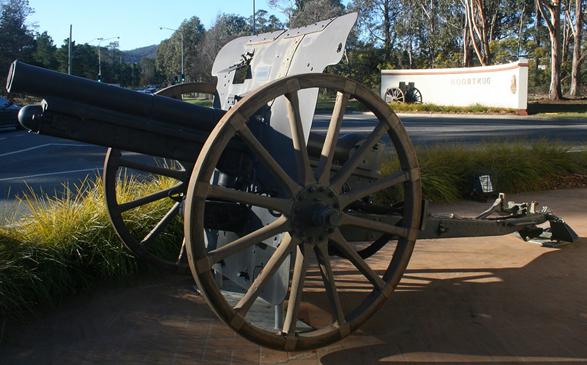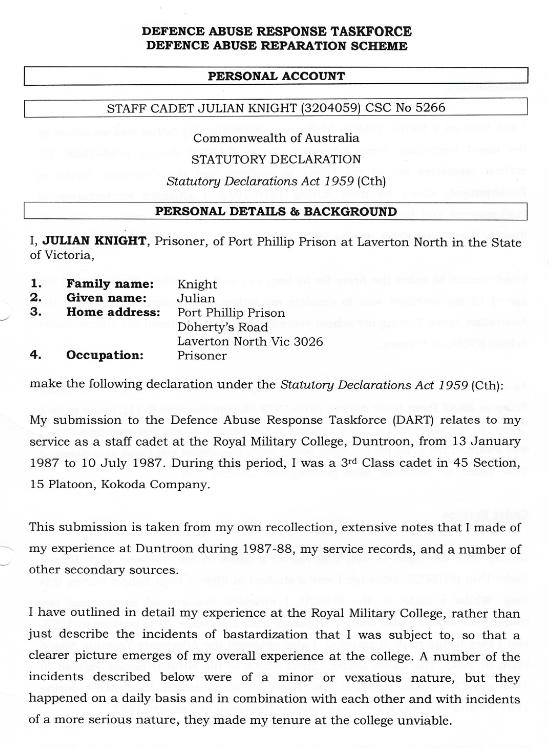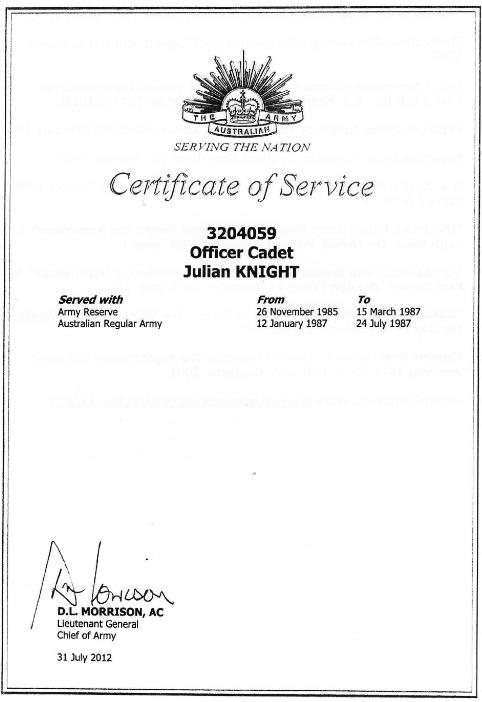Chronology:
30 Jul 86: Julian applies for entry into the January 1987 intake of the Royal Military College, Duntroon in Canberra, Australia to be trained as an Army Officer staff cadet and undertakes a series of aptitude tests and interviews by the Army in central Melbourne
31 Jul 86: Julian purchases a M14 7.62mm (.308) calibre semi-automatic military assault rifle from a Melbourne gun dealer
Sep 86: Now being an adult, Julian is legally able to apply for and receives Freedom of Information documents…
1 Sep 86: Julian attends examination day for entry into the Royal Military College. Passes examinations and advanced to the RMC Selection Board interview process
2 Oct 86: Julian attends the Selection Board for Royal Military College at the Watsonia Army Barracks (located in north-western metropolitan Melbourne). He passes and is placed on a “short list”.
3-19 Oct 86: Julian attends the Army Reserve Radio Operators Course at Sale, Victoria, and is recognised as the course’s ‘Student of Merit’
16 Oct 86: Julian is informed of his acceptance into the January 1987 intake of the Royal Military College

Nov 86: Julian attends 4th/19th PWLH Regimental Annual Range Shoot weekend at Puckpunyal, and attains the highest score in the Regiment with the L1A1 Self-Loading Rifle Represents 4th/19th PWLH in the 3rd Military District’s 1986 Army Reserve Inter-Unit Military Skills Competition at Fort Gellibrand and Merritt Rifle Range, Williamstown, Melbourne.
SOURCE: http://julianknight-hoddlestreet.ca/ [2013-2017]
In Julian’s own words:
RMC Duntroon Officer Selection Training
“In January 1986, the Australian Defence Force Academy (ADFA) opened as a tri¬service officer training establishment as a campus of the University of New South Wales.
It replaced the Army’s RMC Duntroon, the Navy’s Jervis Bay and the RAAF’s Point Cook officer training establishments. The “old” RMC Duntroon, which had operated from 1911-1985 as a 4-year training college, was transformed into a “new” 18-month officer training establishment as a replacement for the 12-month course that had operated at OCS Portsea during 1952-1985. Although I had dreamed of attending OCS Portsea, by the time I was old enough to enlist as an officer cadet it had been replaced by the “new” Duntroon.
On 4 March 1986, I turned 18-years-old.
On 30 July 1986, I applied for entry into the January 1987 intake of RMC Duntroon.
On 1 September 1986, I attended the examination day for entry to RMC at the Defence Force Recruiting Centre in Melbourne. I passed this stage of the selection process and proceeded on to the Officer Selection Board.
In the Commanding Officer’s Report to the Selection Board my Squadron Commander at 4th/19th PWLH, Major Peter ALKEMEDE, made the following final assessment of me: ‘Tpr Knight has only served in B Sqn for a short time but since joining has impressed his NCOs with his enthusiasm and willingness to undertake additional duties. I consider that Tpr Knight is suitable for consideration by the Selection Board for Officer Selection.’
On 2 October 1986, I attended the Selection Board for RMC at Simpson Barracks, Watsonia. The Board consisted of four middle ranking serving officers (Lieutenant-Colonel P.E. BUNYAN, Lieutenant-Colonel J. ROBERTSON, Major o. STRACHAN and Major P. NEUHAUS).
I later learned that the Selection Board believed that I had been “fully briefed” by my father before attending the Selection Board. This was not the case.
All of the Selection Board members rated me as borderline or satisfactory in nearly all of the assessment areas. They were unanimous in grading me as weak in Intellectual Potential and Academic Potential. My Peer Group Assessment in both Friendship and Leadership were rated as good. The other members in my group, three serving soldiers and three civilian applicants, rated me as 1 in both categories, which was the highest mark of a scale of 1 to 6.
The Selection Board members were also fairly consistent in their final evaluation of me as a potential ARA officer. In the ‘Comments’ section of their Profile Reports, three members of the Board expressed their opinion that I might not be able to cope with the academic work at RMC. Lieutenant-Colonel BUNYAN noted that I:
‘was able to contribute to most of the exercises and the rest were prepared to follow. He is well motivated to the Army and is keen to learn… He has more than he is shovving although he may fmd the academic work at RMC difficult.’
Lieutenant-Colonel ROBERTSON wrote that I was a ‘strong performer’ who was ‘effective and supportive of others.’ He also noted that during the practical exercises in the gymnasium I ‘showed strong verbal skills and virtually ran the group.’
He also noted my ‘Strong motivation for the military.’ Major STRACHAN commented that I ‘presented strongly, he was confident and forthright in his manner. He participated in and directed group activities. However consider he may be overconfident and his ability may not match his belief in himself.’
Major NEUHAUS noted that I was: “Generally a reasonable candidate’, although ‘his performance today was made to appear better because of a very weak group.”
Each member of the Selection Board was required to give an overall grade on a scale of:
- Good
- Satisfactory
- Adequate
- Marginal
- Not Yet
- Not Suitable
Although I was graded as ‘Adequate’ by the Psychologist, I was graded as Marginal by the President, Military Member and Academic Member. My Final Board Grading was ‘Marginal’, the lowest grade for acceptance to RMC.
“Has definite limitations which make him … a marginal selection. Could develop into an adequate junior officer.”
As a result of my final grading, I was placed on the short list for the January 1987 intake at RMC. One other member of my Selection Board group, Glynn LOVEGROVE (CSC No 5275), was also placed on the short list for the January 1987 intake.
On 16 October 1986, whilst attending a radio operators course at Sale with my Army Reserve regiment, I was informed that I had been placed on the list of candidates for the January 1987 intake at RMC.
On 18 December 1986, I was informed of my acceptance into the January 1987 intake at RMC.”

[SOURCE: Julian Knight’s Personal Account of RMC Duntroon to the Australian Parliament’s Defence Abuse Response Taskforce, 2013, pp. 4-8].


